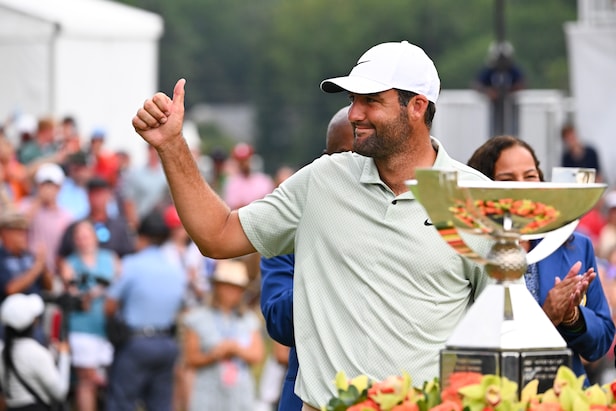British Open 2024: How hard can the 123-yard Postage Stamp really be? Our deep-dive explanation – Australian Golf Digest

- by Admin
- July 13, 2024

To put the absurdly confounding difficulty of the relatively microscopic 8th hole at Royal Troon in perspective, consider this: The average proximity to the hole on the PGA Tour for a shot played at a similar distance to the 8th’s 123 yards is just a shade over 20 feet. Whether the pin is set in the front, middle or back on the hole’s relatively wee putting surface, such a miss could very well not be on the green.
And that’s not even factoring in Royal Troon’s standard issue of blowing winds that come from all directions to a green protected by runoffs, an epic sand hill and bunkers as comfortable as coffins. At its narrowest the 420-square foot green is only nine yards wide, and for perspective, its entire area could fit into the average green on the PGA 14 times. The 8th hole got its moniker when an article in Golf Illustrated article in 1922 referred to its green as “a pitching surface skimmed down to the size of a Postage Stamp.”
What could explain the difficulty of this flick-wedge of a hole—and difficult it is, having played over par the last time the Open Championship was contested at Royal Troon? Maybe it is the expectation that such an exercise should be easy. That inevitable sense of overconfidence infiltrates a golfer’s psyche like a regrettable earworm of disco hits. It can’t be hard, of course, until it is.
While several holes in one have been recorded here in Open Championships over the years, most notably by Gene Sarazen at the 1973 Open when he was 71 years old, it is the improbable disasters that are its hallmark. Ian Baker Finch’s horrific 92 at the 1997 Open was sparked by a double at the short hole, while Tiger Woods officially dropped out of contention that same year with a 6 at the 8th, including a three-putt. There have been 7s and 10s and even a 15, but in all of those cases, the difficulty and despair starts with a missed wedge shot.
Stuart Franklin
But how hard is that wedge shot really? Surprisingly hard when the wind blows as it often does at Troon. While the green lurks over a gully, the shot itself is downhill leaving the ball exposed to the uncertainty of the downhill compounded by the consternation of the breeze. It has played over par in each of the last three Opens played at Royal Troon, and there were more double bogeys recorded on the hole than any of the par threes, including the otherwise beastly 17th hole.
More From Golf  ‘Every Hole At’ British Open 2024: Our hole-by-hole drone tour of Royal Troon Our test
‘Every Hole At’ British Open 2024: Our hole-by-hole drone tour of Royal Troon Our test
To experience the Postage Stamp’s confounding variabilities without splurging for airfare, we conducted our test using a Trackman simulator. We had three players—two scratch, one an 11-handicap—hit a series of shots on the 8th under gradually worsening conditions.
Playing in the most benign, and least likely, conditions—no wind and receptive greens—the hole appears vulnerable. The average proximity out of six attempts for even our 11-handicap was 23 feet, just outside the aforementioned PGA Tour average.
But it was when we ramped up the severity that the hole turned nasty. In a 15-mph left-to-right crosswind, our scratch players’ average proximity tripled in distance.
And by the final stage, a 35-mph headwind, the outcomes were comical, with our mid-handicap swinging full drivers, only to see his ball ballooning into the adjacent fairway.
The average player data? Not pretty
We also asked the team at Arccos to get a read on what real golfers do, and the numbers were predictably disastrous. While the average score was a semi-respectable 3.8, when you dig a little deeper, you see that the typical golfer hit the green less than half the time with an average proximity to the hole of more than 50 feet. Average golfers are making double or worse one in five times.
Like is so often the case at a links course, the wind tells the story. We charged the ball-flight simulation researchers at Foresight Sports, makers of the GC Quad launch monitor, to project what might happen to a typical wedge shot with a 25 mile-per-hour wind, the results were kind of frightening.
Downwind shots were missing the green by more than 30 yards, while shots into a headwind came up 40 yards short. No less disconcertingly, some crosswind shots ended up in a bunker—in the fairway on the 7th hole. Obviously, when actually playing the hole golfers will adjust both their aim and technique to get a more playable result, but the calibrations seem no less complex than trying to deliver a pizza by drone in a typhoon.
This wind effect is a particularly nettlesome problem at the Postage Stamp for two reasons. Since it is short and often plays into the wind, players face two things working against their ball flights. Based on our calculations, shots into the wind are effected more than the same windspeed downwind, while shots with more loft also are penalized more than shots with less loft. Toss in the slight downhill nature of the hole into the club choice calculations and players are left somewhat with a hit and hope scenario.
Of course, since the surroundings include bunkers and deep grass, neither of which provides a clear path for direct extrication, compounded by a tiny rounded green, you can see how an unwanted game of back-and-forth volleyball might lead to a situation where the possibility for high scores escalates quickly.
All of this ugliness makes us wonder if the Postage Stamp is a bit of cheeky trickery or a true test of the varieties of skills that good golf should require. Locals also know the hole as the Wee Beastie, which would be a complement to a bantamweight UFC fighter but for a golf hole seems quaint, like driving a Mini Cooper. Until you play it and you realize that any miss virtually assures bogey or worse. If the goal is to get your 3 and get out, that sentiment simply doesn’t rightly add up with the hole’s tiny length.
But maybe a local like Colin Montgomerie, whose father was the club secretary at Troon for many years, can explain the 8th’s frightening dichotomy best. “You could throw it on, really,” he said. “On paper you think of it as a birdie chance, but it’s a potential card wrecker. Always was and always will be.”
This article was originally published on golfdigest.com
The Latest News
-
January 5, 2025‘It’s only for certain people’: The ruthless reality of tennis qualifying
-
January 5, 2025India’s devastating Bumrah injury as Aussies chase 162
-
January 4, 2025Small businesses breathe new life into historic churches
-
January 4, 2025California desert course, designed by Robert Trent Jones Jr. and once led by NHL Hall of Famer, has shut down – Australian Golf Digest
-
January 4, 2025Live: Australia makes explosive start to 162-run chase in bid to win Test series




